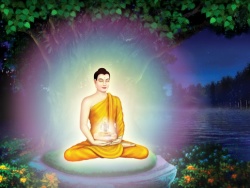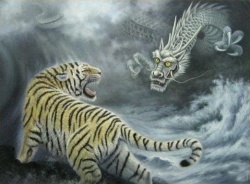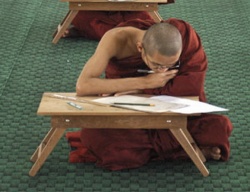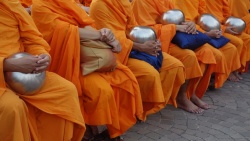Difference between revisions of "Logic in the Katthāvattu"
m (Text replacement - "one thing " to "one thing ") |
m (Text replacement - "[[[" to "([[") |
||
| Line 87: | Line 87: | ||
It is now-a-days claimed that a logician's [[concern]] is with the validity of {{Wiki|inference}}, not with its soundness, which may depend on extra-logical factors (the [[truth]] of the premises). | It is now-a-days claimed that a logician's [[concern]] is with the validity of {{Wiki|inference}}, not with its soundness, which may depend on extra-logical factors (the [[truth]] of the premises). | ||
| − | This is the {{Wiki|ideal}} in | + | This is the {{Wiki|ideal}} in ([[Western]]] {{Wiki|formal logic}}. In [[India]], however, this {{Wiki|distinction}} was not often made, for the [[philosophers]] wanted their “[[logically]]” derived inferences or their conclusions also to be pieces of [[knowledge]]. Thus, validity must be combined with [[truth]]. (17) |
He points out that a commonly used example in {{Wiki|modern}} [[scholarly]] [[writing]] about [[Indian]] {{Wiki|reasoning}}, “Wherever there is smoke, there is [[fire]]. There is smoke on the yonder hill. | He points out that a commonly used example in {{Wiki|modern}} [[scholarly]] [[writing]] about [[Indian]] {{Wiki|reasoning}}, “Wherever there is smoke, there is [[fire]]. There is smoke on the yonder hill. | ||
Revision as of 20:30, 3 April 2016
This is the other paper I wrote for the Buddhist Philosophy class, much in the same vein as the previous one.
I didn't feel like I could move on to the content of the arguments in the texts without better understanding the manner of argument or reasoning.
I still have a lot of work to do in that regard!
Buddhist Philosophy Prof. Sumana Ratnayaka SIBA, August, 2012
- According to A.K. Warder, “In the Kathāvattu. . . we have the earliest known Indian philosophical work which proceeds on the basis of a set of established logical techniques” (287). If this is so, the arguments of the Kathāvattu might therefore lend themselves to representation in common systems of symbolic logic. However, scholars have differed over the best way to to this. If we attempt to represent the arguments in the Kathāvattu in terms of western symbolic logic, what is the best way to do so? How can we best represent the arguments of the text in a way that is revelatory about our best understanding of their true meaning? I will look at a few such attempts to represent the first argument of the text and discuss their relative merits.
- First, let us look at the initial argument, which represents an exchange between a Theravādin and a Puggalavādin ('personalist', or someone who believes in a persisting soul, self, or person). As translated by Aung and Rhys Davids, the exchange is as follows:
Th: Is 'the person' known in the sense of a real and ultimate fact?
Pg: Yes.
Th: Is the person known in the same way as a real an ultimate fact is known?
Pg: Nay, that cannot truly be said.
Th: Acknowledge your refutation: If the person be known in the sense of a real and ultimate fact, then indeed, good sir, you should also say, the person is known in the same way as [any other] real and ultimate fact [is known].
. . .In affirming the former statement, while denying the latter, you are wrong.
(Italics and brackets in original, 8-9)
Kalupahana renders the same passages as:
Th: Is a person obtained as an absolute truth, as an ultimate reality?
Pg: Yes.
Th: Is a person, as an absolute truth, as an ultimate reality, obtained in the same way that an absolute truth, an ultimate reality, is obtained?
Pg: One should not say so.
Th: Admit your refutation.
If you say that a person is obtained as an absolute truth, as an ultimate reality, then you should also say that a person is obtained as an absolute truth, as an ultimate reality, in the same way that an absolute truth, an ultimate reality, is obtained.
. . . What you state [, that one 'should say' the former and 'not say' the latter,] . . . is wrong. (Italics in original, brackets mine, 134)
I will compare three representations of this argument and see if we can find reason to choose one over the others, or if perhaps there is yet another preferred alternative.
I. The term-logical representation of Aung and Bochenski.
- Matilal reconstructs the term-logical representation (the variables range over terms, not propositions) of the argument from Aung and Bochenski as follows:
If A is B, then A is C. Therefore not both: (A is B) and not (A is C). Therefore: if not (A is C) then not (A is B). (36-37)1
In this representation, 'A' is 'the person', 'B' is the characteristic of being found as a “real and ultimate fact” or “as an absolute truth, as an ultimate reality”, and 'C' is the characteristic of being found in the same way as other such realities are found - or in Kalupahana's account as any such reality would be found (more on this later).
Although this representation does not match the structure of the presentation of the argument from the text, it does seem to me on its face to well represent the logical structure of the argument itself. That is, there are clearly three distinct 'terms' being compared in the text, and this logical formulation captures that fact and the stated relations of those terms well.
II. Jayatilleke's propositional representation.
- Jayatilleke claims that the term-logical account misrepresents and obfuscates the argument (414-415), stating that it is better to represent the argument using simple propositions as:
p ~q p → q ├ ~p (413)
Here p represents the assertion that 'the person is found as an ultimate reality' and q represents that 'the person is found in the same was as other/any ultimate realities'. As Jayatilleke argues, this representation indeed has the advantage of matching more closely the presentation of the argument in the text (414-415).
That is, the Puggalavādin is depicted first as assenting to p, then denying q, at which point the Theravādin asserts the connection between the two claims in order to refute the Puggalavādin's initial claim. Jayatilleke also argues that the Kathāvattu, like “the Buddhist tradition as a whole” considers propositions as wholes rather than breaking them down into terms (313, 414).
However, even if that be the case, the reduction of the statements to bare propositions rather than term comparisons seems to me to obscure the nature of the argument.
- Matilal argues that the distinctive characteristic of “Indian logic” as opposed to “Western logic” is that the former includes epistemological issues, where the latter excludes them (14). That is to say, the Indian approach did not emphasize the distinction between formal validity and argumentative soundness:
It is now-a-days claimed that a logician's concern is with the validity of inference, not with its soundness, which may depend on extra-logical factors (the truth of the premises).
This is the ideal in (Western] formal logic. In India, however, this distinction was not often made, for the philosophers wanted their “logically” derived inferences or their conclusions also to be pieces of knowledge. Thus, validity must be combined with truth. (17)
He points out that a commonly used example in modern scholarly writing about Indian reasoning, “Wherever there is smoke, there is fire. There is smoke on the yonder hill.
Therefore there is fire there,” when presented in the ancient Indian texts was actually formulated as “The hill is fire-possessing. Because it is smoke-possessing.
For example, the kitchen” [[[Wikipedia:emphasis|emphasis]] added] (15-16).
The Indian formulation has an example demonstrating the smoke to fire relation as a central element of the argument, relying on the analogy to the kitchen for the soundness of the argument.
If we accept this epistemological character of Indian logic, then we may conclude that Jayatilleke's propositional representation of the argument obscures the important fact that it is indeed terms that are being compared.
The Theravādin is arguing that, once the Puggalavādin places the person in the category of ultimate truths, he should also accept that the person should have the other characteristics commonly associated with those truths – in this first case, how they are known. It is significant in this regard that the text continues on to compare the person to many other 'things known' and how they are known.
Jayatilleke's representation of the argument obscures this comparative or analogical characteristic of the debate.
III. Kalupahana's analysis of the argument
- While Kalupahana agrees with Jayatilleke that only two variables are needed to represent the argument, and therefore that the propositional form captures the structure of the argument, he claims that both of these interpretations miss the actual content of the argument (134-136).
Kalupahana suggests that, rather than p and q,we would be better served by seeing the propositions as
pTR (person in truth and reality) and TR (truth and reality) (135).
Here the full forms of these statements are given by Kalupahana as pTR: “A person is obtained as an absolute truth, as an ultimate reality” and TR: “An absolute truth, an ultimate reality, is obtained” (135).
In terms of the logical structure, Kalupahana would presumably agree with Jayatilleke's representation, so long as the substitutions of pTR and TR for p and q respectively have been made, giving:
pTR ~TR
- pTR → TR
├ ~pTR
But he argues that both the accounts we have looked at miss the actual point of the argument. Kalupahana calls out two aspects of the text that are not directly addressed in the other two accounts.
- First, which we have already alluded above, is his claim that the Theravādin's second proposition, q or 'A is C' or TR, is referring to the possibility of attaining any absolute truth or ultimate reality as opposed to comparing the nature of the person to other accepted absolute truths.
His claim is that all the scholars we have looked at so far were mislead by Buddhaghosa's interpretation of the Theravādin's second question (135).
Buddhaghosa's commentary interprets: “'In the same way,' that is either as the factors of mind and body are known, by immediate consciousness, or under one of the twenty-four relation-categories” (emphasis added, Aung 9n2)2.
Kalupahana's claim to the contrary is that the Theravādin is actually asking whether any ultimate reality can be obtained, and in this regard that the peculiar nature of the Puggalavādin's reply is also significant.
This is his second distinction, that the Puggalavādin's “One should not say so” is not a simple negation of a proposition, but rather a claim that the category of ultimate reality is unspeakable:
Both seem to assert that one should not speak (na vattabbe) of an absolute truth or ultimate reality (TR).
Yet the Personalist proceeds to assert a person as an absolute truth, as an ultimate reality (pTR), while the Theravādin does not. . . .
This means that the Personalist believes that “what cannot be spoken of” (na vattabbe) can still be obtained or experienced, whereas the Theravādin insists that what is unspeakable is also not obtained or experienced. (136-137)
In Kalupahana's view, the Puggalavādin and Theravādin are both closer to his interpretation of early Buddhist non-essentialism than the tradition has either of them, for in his view they both agree to the unspeakable nature of the absolute, whereas the tradition has them arguing over what phenomena fit in the category of the absolute, with the battle against absolutism having already been lost or abandoned.
- Kalupahana believes that Buddhaghosa “advertently or inadvertently” introduced “absolutist or substantialist distinctions. . . into the Theravāda tradition” (133). Because the Theravāda tradition subsequently takes the Abhidhamma to be dealing in 'ultimate truths', when Buddhaghosa compares the 'way the person is known' to the way these other specific truths are known, it leads to the conclusion that the Theravādin of the Kathāvattu is asking the Puggalavādin to compare his knowing of the person to the accepted knowing of these other 'ultimate truths'. On the contrary, Kalupahana argues that it is the very Kathāvattu that evidences against this interpretation of the Abhidhamma, as “No one reading the excessively long debate in the Kathāvattu on the conception of a person can assert that the Abhidhamma deals with ultimate realities (paramattha)” (145).
However, the Theravādin does to assert that 'material quality' is known as a 'real and ultimate fact' as well as the rest of the fifty-seven 'ultimates'.
For example, take the following question posed by the Theravādin: “Material quality [rūpaṃ (Aung 15n3)] is (you have admitted) known as a real and ultimate fact.
Feeling, too, is known as such. Now, is material quality one thing and feeling another?” (17)
Assuming we have an adequate translation, it is clear in this passage that the Theravādin is indeed assenting to there being 'real and ultimate facts', for he states that feeling “is known as such” rather than asking whether it is.
One could still argue about the nature of 'real and ultimate facts'.
For example, are they absolutes, independent of human experience, or just inevitable aspects of human experience?
But Kalupahana's position rests on the assertion that the comparison to these other facts is not being made in the first argument, whereas the rest of the text, independent of Buddhaghosa's analysis, would seem to indicate that the comparison is indeed intended.
Conclusion
- Given the limitations I have outlined for the representations provided by Jayatilleke and Kalupahana, but acknowledging Jayatilleke's argument that the original term-logical representation obscures the structure of the debate as presented in the text, I think the best representation may therefore be a term-logical representation rearranged to match the presentation in the text, that is:
Pg: A is B
Pg: ~(A is C)
Th: (A is B) → (A is C)
Th: ├ ~(A is B)
Here we have the Puggalavādin first assenting to the person (A) being an ultimate reality
(B), but not being known in the way of other ultimate realities
(C), followed by the Theravādin's assertion that the former implies the latter and therefore that the Puggalavādin's original assertion cannot stand alongside his second.
This could perhaps be made more clear by rendering it in predicate logic:
- Pg: (Ǝx)(Px · Rx) “Some person is known as a reality.”
- Pg: ~(Ǝx)(Px · Kx)3 “No person is known in the way other realities are known.”
- Th: (x)(Rx → Kx) “All realities are known in the way other realities are known.”
- Th: ├ ~(Ǝx)(Px · Rx) “Therefore no person is known as a reality.”
This rendering has the advantage of making the Theravādin's argument more clear in that the third statement is more suggestive of why the Puggalavādin's statements are contradictory.
However, all we have in the text are statements to the effect of “if you say the person is known as a reality, you should say it is known in the way other realities are known”, so the Theravādin could in fact have reasons other than the belief that all realities must be known in the same way for making this assertion.
Also, to be more accurate, we should probably introduce a particular for the known person, for it is not clear that the Puggalavādin is arguing about any notion of a person as opposed to merely making claims about his own notion of such.
- Because the predicate rendering opens up these additional questions, it is perhaps best not to recommend it without further analysis of the rest of the comparative arguments made in the text. For the present therefore I propose the rearranged term-logical rendering as preferable to the alternatives presented in the texts examined here and leave the question of the predicate rendering for future study.
1 Matilal claims (37) that this is Aung's representation, but Aung's representation has four terms (If A is B then C is D; But C is not D; Therefore A is not B (xlviii)).
Matilal says Bochenski “gave an improved version of the same” (37), and Jayatilleke says that Bochenski “seeks to reinstate” Aung's account but improves on it by using only three terms instead of four (Jayatilleke, 412 and n.4).
Therefore, having been unable to obtain a copy of Bochenski to check for this paper, I am relying on Matilal's representation of the argument as being equivalent to that by Bochenski (against which Jayatilleke frames his discussion.)
2 Law's translation of this passage is “'In the same way'. . .here it means. . . 'Is the 'person' got at in the same way as a real and ultimate object is got at, because of its having either material form and the like, or because of the relation-categories and the like?'” (11).
3 Suber suggests (tip 18) that this would be better rendered as “(x)(Px → ~Kx)” (and similarly for the fourth statement), but I think the rendering I give here is easier to read as the English statements I have provided to approximate the claims as they are made in the text.
Also, the existential rendering of the fourth statement is easier to see as the direct negation of the Puggalavādin's initial assertion, whereas the universal rendering requires a little more understanding of predicate logic on the part of the reader.
Works Cited
Aung, Shwe Zang and Mrs. Rhys Davids. Points of Controversy, or, Subjects of Discourse: Being a translation of the Kathāvattu from the Abhidhammapiṭaka. 1915. Oxford: Pali Text Society, 1993.
Bochenski, I. M. A History of Formal Logic. 1956. 2nd ed. Trans. I. Thomas. New York: Chelsea Publication Company, 1961.
Jayatilleke, J. N. Early Buddhist Theory of Knowledge. 1963. Delhi: Motilal Banarsidass, 1963.
Kalupahana, David J. A History of Buddhist Philosophy: Continuities and Discontinuities. 1992. Delhi: Motilal Banarsidass, 1994.
Law, Bilma Churn, trans. The Debates Commentary. London: Humphrey Milford, 1940.
Matilal, Bimal Krishna. The Character of Logic in India. Eds. Jonardon Ganeri and Heeraman Tiwari. Albany: State University of New York Press, 1998.
Suber, Peter. Translation Tips. Department of Philosophy. Earlham College. n.d. Web. 22 Aug. 2012. <http://www.earlham.edu/~peters/courses/log/transtip.htm>
Warder, A. K. Indian Buddhism. 3rd ed. Delhi: Motilal Banarsidass, 2000.
Posted by John Emmer









